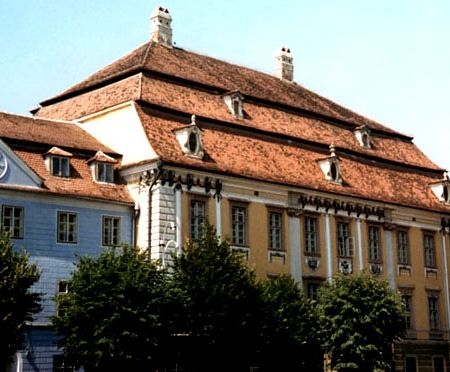
When Samuel von Brukenthal decided to raise a gorgeous residence in Sibiu in neighborhood of the town square, on the north side of the medieval square there were already two buidings: a large church and the Jesuitical seminary (1726).
By demolishing the house of his wife inherited from her father, Senator Georg Klöckner, and other buildings purchased in the neighborhood (1775), Samuel von Brukenthal obtained suitable land on the western side of the square to construction the palace, a year after his appointment as governor of Transylvania (1777).
Unfortunately, neither today is not well-known the name of architect of the Brukenthal Palace, opinions of specialists aiming name as Johann Blaumann (architect from Sibiu, builder of the Banffy Palace in Cluj) or one of the architects of Viennese Martinelli family, Josef Frantz, but no documentary coverage, is the only hypotheses. Though, clearly, the final decision by encouraging a project belonged to the beneficiary.
Palace has a rectangular plan, including between its sides an inner courtyard.
Regarding the main facade of the palace the architect was somewhat removed from the canons of a baroque spectacular, showing a predilection for a weighted style.
To first floor is given special attention according the Baroque style. Among the first floor rooms distinguish five rooms located in front. The most gorgeous is the music room, along the receiving room and in side there were the cabinets. Three central rooms preserves the original silk wallpaper and the cabinets prove the interest in chinoiserie, the offices having painted wall with oriental motifs: trees, bushes of flowers, exotic birds. Therefore the side rooms are entitled rooms with birds. For this kind of work they were hired Johann Tauffer from Viena and Nicolaus Jaffer from Eisenstadt.
Brukenthal Palace in Sibiu is one of the treasures Baroque art in Central Europe. The main facade of the palace was amenable to restoration efforts in the 1973-1974. In 1998 the building was amenable to new restoration.
The art collection was founded by Samuel von Brukenthal starting in the middle of the eighteenth century. The paintings come from old collections, such as the archduchy Leoplod Wilhelm or purchases made by Brukenthal, either personally or through painter Johann Martin Stock.
The Baron acquired less paintings directly from the artists, being known only when called for this purpose the painters Martin Meytens and Franz Neuhauser jun. Collector activity was sustained during several decades, purchasing more than 1,000 paintings from different European schools.

































